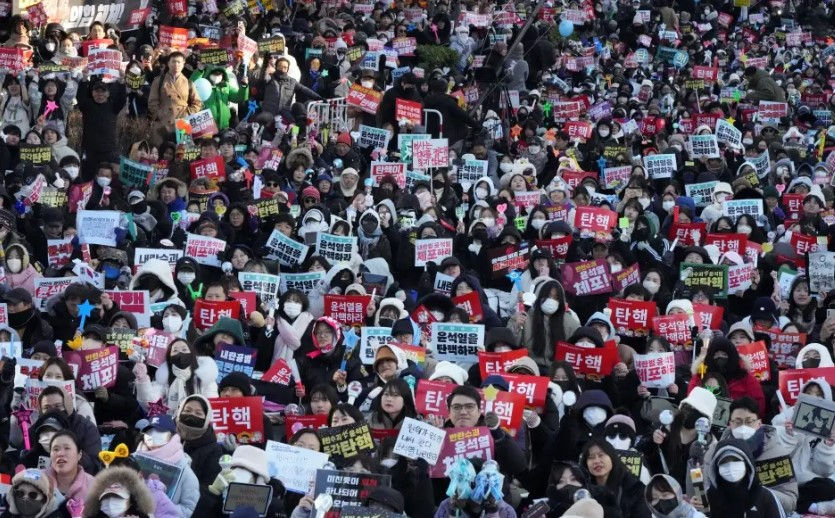COLUMN: A threat to American arts and music: The dangerous politicization of the Kennedy Center
- Wonjeong Hong
- Mar 7
- 3 min read
Source
Article Summary
For decades, the Kennedy Center has served as a platform where artists from diverse backgrounds can freely share their works and enrich the nation with creativity and diverse expression in fields such as dance, music, theater, and more.However, the living memorial to President John. F. Kennedy's vision faces threats due to the dangerous politicization brought into the art by Donald Trump's administration.
Trump recently intervened in Kennedy Center's leadership and replaced the long-respected chair of the board with his political allies, turning the traditionally nonpartisan institution into a stage for ideological and political influence and diminishing the creativity and diversity that were the key values of the Kennedy Center. This intervention damages artistic independence and threatens the safe space to express diverse perspectives freely. Trump has been targeting expressive outlets to threaten creative independence to increase his political and ideological power and control over society. Shutting down the DEI policies is one of his efforts.
The new president has replaced the respected and acknowledged leaders of the Kennedy Center, like Deborah Rutter and Ben Folds, with his billionaire political allies, such as Richard Grenell and Susie Wiles.Trump's effort to weaponize art and initiate push his narrow view of "traditional American culture" resulted in cultural homogeneity and exclusion, and marginalization of the social minority group's voice. Art institutions should accept and embrace different perspectives and cultures, not judging or filtering out what's suitable for the president's cultural plan.
The partisan politicization of the Kennedy Center also threatens the local colleges, art schools, and communities around the country, which can lead to reduced funding for creative and accessible educational programs. The ripple effect can hamper emerging artists who are already struggling for visibility to grow, hinder innovation, and threaten creativity and freedom across the nation. It is not just changing the leadership boards, it is turning a creative outlet that respects various voices and freedom into partisan, ideologized, and polarized battlegrounds of political views.
Reflection
Art and creativity cannot flourish without the soil of artistic independence and freedom and open space where different and various perspectives can be shared. Therefore, Trump's attempt to partisan politicize the Kennedy Center, which has traditionally been a platform that provides those soils and enhances the creativity of various types of artists, is against the basic concept of artistry.
Creative and artistic outlets have been affected by and affected politics and social situations. This is especially significant because art is a tool that conveys the views and voices of the minority, who are often marginalized and excluded from mainstream society. Art's expressive and creative nature allows people to have new perspectives or pieces of information about the thoughts and lives of people in specific groups, indirectly affecting society's ideology.
Therefore, Trump's attempt to reduce the DEI policies and replace the original respected leadership boards of the Kennedy Center is an attempt to regulate and censor the various views that art can provide for his political and ideological control. It is related to the types of cultural images that Trump is trying to show and deliver to Americans.
For example, during the Obama and Biden administrations, there was much support and funding for Black and LGBTQ+ Artists, who are often regarded as minorities. However, due to Trump's DEI crackdown, the D.C. Art Museum of Americas canceled several exhibitions of Black and LGBTQ artists in February 2025. Furthermore, the show on artists of African Descent lost funding.
The history of censoring art by the government for political purposes has always been a thing. Art and culture are some of the most popular targets of censorship because of their vast influence over society and their usage as a tool of global and social activism. The first federal attempt to censor creations against the government was recorded in the passage of the Alien and Sedition Acts of 1789 under President John Adams. The act made speaking, writing, or printing criticisms of the government that were false, scandalous, or malicious as a federal crime.
Censorship in art was especially at its peak during the paranoid anti-communism of the late 1940s and 1950s and the Cold War era. Politicians regarded different schools of modern art as evil and asserted that popular artistic movements, such as Cubism, Futurism, Dadaism, and Surrealism, destroyed society by causing disorder in 1949. Picasso was also called Pinko and often got censored.
Nevertheless, these censorships often fail because political situations constantly change, affecting mainstream ideology. In addition, marginalizing and censoring the voices of specific artists is difficult because art is one of the universal tools and activities to express an idea or cultural identity. It contains the history of counterculture movements, overall social situation, and paradigm. Paradoxically, many governments, including the Trump administration, are obsessed with taking control of the art. However, art will always find its way to the land of its freedom and never stop criticizing and fighting against the social situation.




Comments